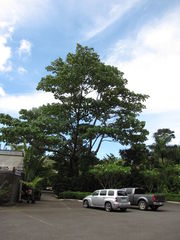Ochroma
| Ochroma subsp. var. | Balsa | |||||||||||||||||||||||||||||||||||||||||||||||||||||||
|---|---|---|---|---|---|---|---|---|---|---|---|---|---|---|---|---|---|---|---|---|---|---|---|---|---|---|---|---|---|---|---|---|---|---|---|---|---|---|---|---|---|---|---|---|---|---|---|---|---|---|---|---|---|---|---|---|

|
|
| ||||||||||||||||||||||||||||||||||||||||||||||||||||||
| ||||||||||||||||||||||||||||||||||||||||||||||||||||||||
Ochroma pyramidale, commonly known as Balsa, is a species of flowering plant in the mallow family, Malvaceae. It is a large, fast-growing tree that can grow up to 30 m ft tall. Balsa trees are native from southern Brazil and Bolivia north to southern Mexico however Ecuador has been the primary source of commercial Balsa. In recent years some Balsa has been plantation grown.[1] It is evergreen, or dry-season deciduous if the dry season is long, with large (30 - 50 cm) weakly palmately lobed leaves. The name balsa derives from Spanish for a raft. Despite being very soft, balsa is classified as a hardwood, and is the softest commercial hardwood. Balsa lumber is very soft and lightweight.
| Standard Cyclopedia of Horticulture |
|---|
|
Ochroma (named for the paleness of the fls.). Bombacaceae. One tree of Trop. Amer., allied to Ceiba: Lvs. simple, angled or lobed: fls. large, terminal, p. Lagopus, Swartz, is listed abroad but hardly a horticultural subject: it is the corkwood or balsa of the W. Indies, from which canoes and other things are made, the wood being very light, the bark yielding fiber: tree to 40 ft. high: Lvs. 5-7-lobed or only angular, nearly entire or dentate, puberulous beneath: petals 5-6 in. long, yellowish white or brownish, somewhat surpassing the column of stamens, obovate and wavy, clawed; calyx 5-lobed, subtended by a caducous involucre of 3 parts; stamens comprising a column which is topped by 1-celled anthers; stigma 5, exserted, spiral: caps. 1 in. long, 5-celled, with reddish brown wool inside.
|
Cultivation
Propagation
Pests and diseases
Varieties
Gallery
-
Painting by Frances W. Horne from the Flora Borinqueña
-
photo 1
-
photo 2
-
photo 3
References
- ↑ United States Department of Agriculture: "The Encyclopedia of Wood", page 1-19. Skyhorse Publishing, Inc., 2007
- Standard Cyclopedia of Horticulture, by L. H. Bailey, MacMillan Co., 1963
External links
- w:Ochroma. Some of the material on this page may be from Wikipedia, under the Creative Commons license.
- Ochroma QR Code (Size 50, 100, 200, 500)


